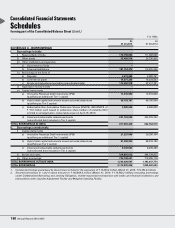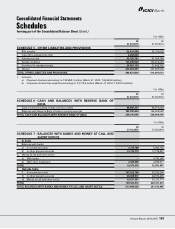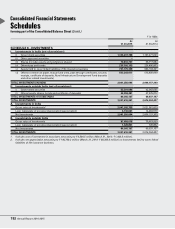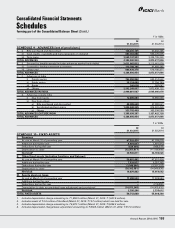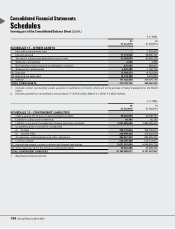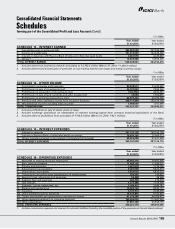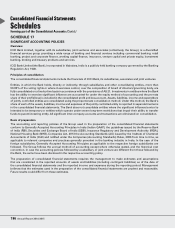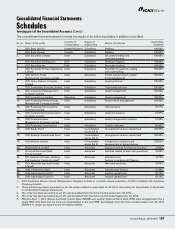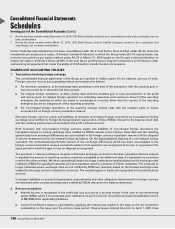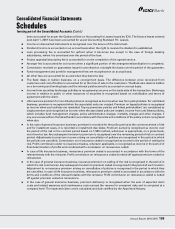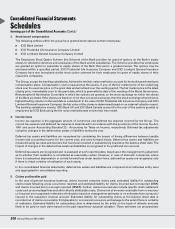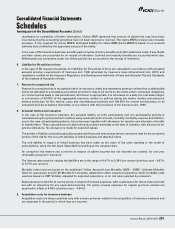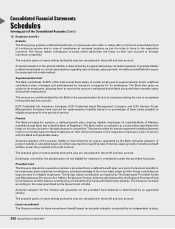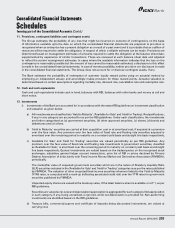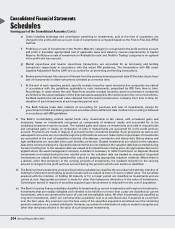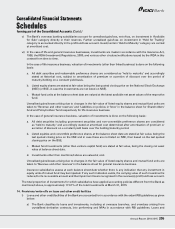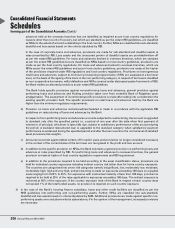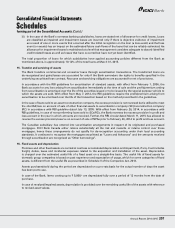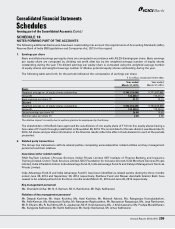ICICI Bank 2015 Annual Report Download - page 202
Download and view the complete annual report
Please find page 202 of the 2015 ICICI Bank annual report below. You can navigate through the pages in the report by either clicking on the pages listed below, or by using the keyword search tool below to find specific information within the annual report.
Schedules
forming part of the Consolidated Accounts (Contd.)
200 Annual Report 2014-2015
Consolidated Financial Statements
3. Stock based compensation
The following entities within the group have granted stock options to their employees:
ICICI Bank Limited
ICICI Prudential Life Insurance Company Limited
ICICI Lombard General Insurance Company Limited
The Employees Stock Option Scheme (the Scheme) of the Bank provides for grant of options on the Bank’s equity
shares to wholetime directors and employees of the Bank and its subsidiaries. The Scheme provides that employees
are granted an option to subscribe to equity shares of the Bank that vest in a graded manner. The options may be
exercised within a specified period. ICICI Prudential Life Insurance Company and ICICI Lombard General Insurance
Company have also formulated similar stock option schemes for their employees for grant of equity shares of their
respective companies.
The Group, except the banking subsidiaries, follows the intrinsic value method to account for its stock-based employee
compensation plans. Compensation cost is measured as the excess, if any, of the fair market price of the underlying
stock over the exercise price on the grant date and amortised over the vesting period. The fair market price is the latest
closing price, immediately prior to the grant date, which is generally the date of the meeting of the Board Governance,
Remuneration & Nomination Committee in which the options are granted, on the stock exchange on which the shares
of the Bank are listed. If the shares are listed on more than one stock exchange, then the stock exchange where there is
highest trading volume on the said date is considered. In the case of ICICI Prudential Life Insurance Company and ICICI
Lombard General Insurance Company, the fair value of the shares is determined based on an external valuation report.
The banking subsidiaries namely, ICICI Bank UK and ICICI Bank Canada account for the cost of the options granted to
employees by ICICI Bank using the fair value method based on binomial tree model.
4. Income taxes
Income tax expense is the aggregate amount of current tax and deferred tax expense incurred by the Group. The
current tax expense and deferred tax expense is determined in accordance with the provisions of the Income Tax Act,
1961 and as per Accounting Standard 22 - Accounting for Taxes on Income, respectively. Deferred tax adjustments
comprise changes in the deferred tax assets or liabilities during the year.
Deferred tax assets and liabilities are recognised by considering the impact of timing differences between taxable
income and accounting income for the current year, and carry forward losses. Deferred tax assets and liabilities are
measured using tax rates and tax laws that have been enacted or substantively enacted at the balance sheet date. The
impact of changes in the deferred tax assets and liabilities is recognised in the profit and loss account.
Deferred tax assets are recognised and re-assessed at each reporting date, based upon the management’s judgement
as to whether their realisation is considered as reasonably certain. However, in case of domestic companies, where
there is unabsorbed depreciation or carried forward loss under taxation laws, deferred tax assets are recognised only
if there is virtual certainty of realisation of such assets.
In the consolidated financial statements, deferred tax assets and liabilities are computed at an individual entity level
and aggregated for consolidated reporting.
5. Claims and benefits paid
In the case of general insurance business, claims incurred comprise claims paid, estimated liability for outstanding
claims made following a loss occurrence reported and estimated liability for claims incurred but not reported (IBNR)
and claims incurred but not enough reported (IBNER). Further, claims incurred also include specific claim settlement
costs such as survey/legal fees and other directly attributable costs. Claims (net of amounts receivable from re-insurers/
co-insurers) are recognised on the date of intimation based on management estimates or on estimates from surveyors/
insured in the respective revenue account. Estimated liability for outstanding claims at the balance sheet date is
recorded net of claims recoverable from/payable to co-insurers/re-insurers and salvage to the extent there is certainty
of realisation. Estimated liability for outstanding claim is determined by the entity on the basis of ultimate amounts
likely to be paid on each claim based on the past experience/ actuarial valuation. These estimates are progressively


